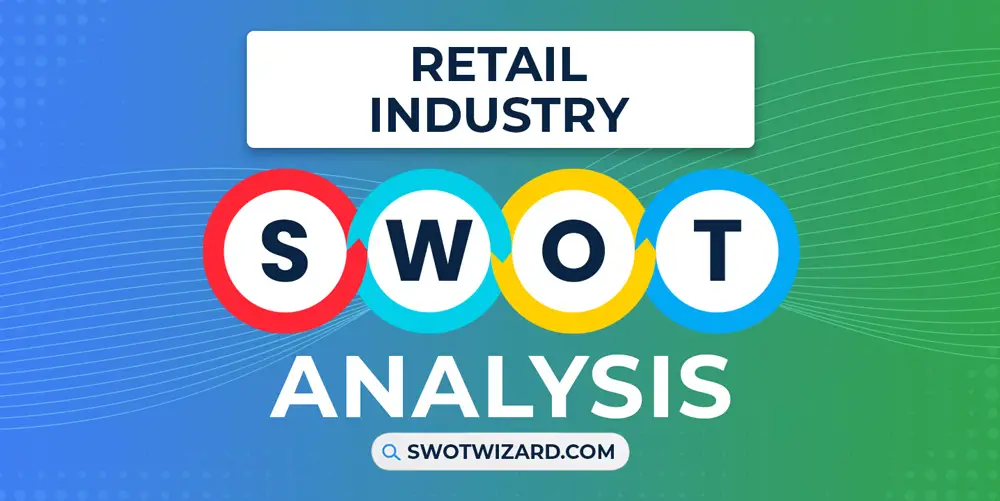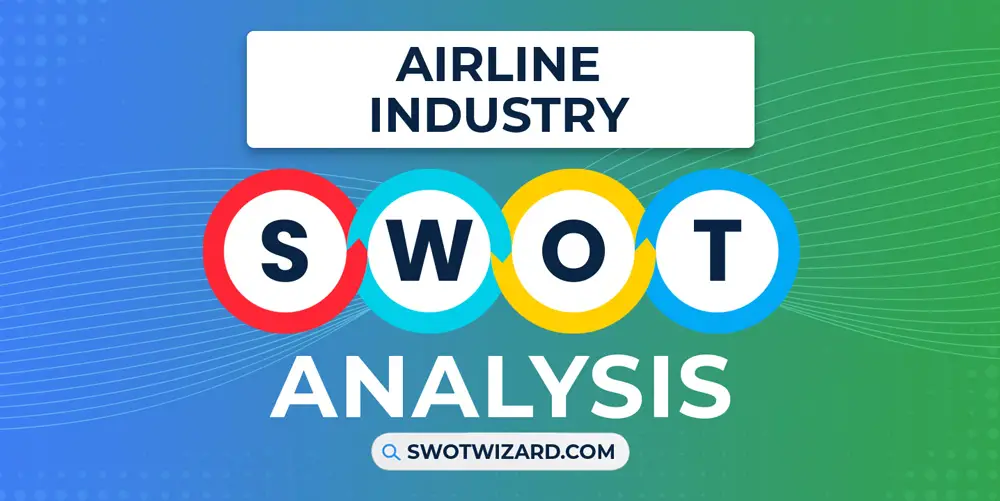In the modern era of globalization, product availability has increased significantly, thanks to the millions of stores worldwide, including hundreds of them near your home. As any industry has its strengths and opportunities to grab, there are also weaknesses and threats to deal with, and here we get to learn about this in the retail industry swot analysis.
Retail Industry Overview
The retail industry’s history dates back to ancient civilizations, but modern retailing began with the Industrial Revolution in the 18th century. The retail sector has experienced significant growth in recent years, with global retail sales reaching $27.7 trillion in 2022.
The industry employs millions worldwide, with approximately 15.7 M in the US retail sector alone. The US has over 2,920,421 retail establishments, and the industry accounts for about $5,570.4 B in the country’s GDP.
The rise of e-commerce has been a significant driver of growth in the retail sector, with global e-commerce sales reaching $1,034 B in 2022.
Competitors in Retail Industry
Walmart | Amazon | Costco | Walgreens | Target | Lowe’s | Home Depot
Did You Know?
More than 60% of the total sales on an average day in a retail sale comes during the lunch and dinner hours.
Strengths – Retail Industry SWOT Analysis
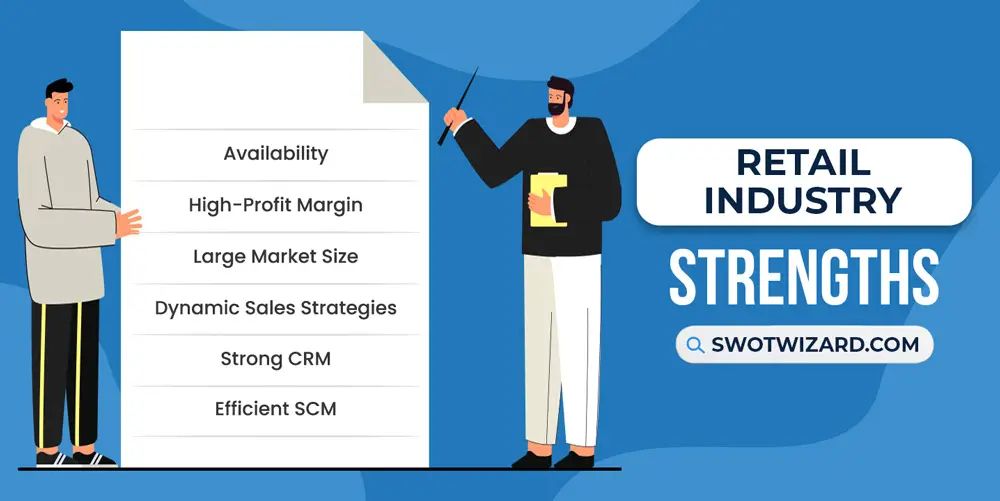
Availability: Whether you live in an urban or remote area, there will be at least a place where you can buy your necessary things. No matter which continent you belong to, items will be available thanks to the availability of retail stores, globalization, and an efficient supply chain.
High-Profit Margin: The entire retail industry enjoys a fair 10% on average profit market globally. But, in some cases, the margin could be up to sixty to seventy percent, depending on the product line or type. But, in FMCG products, daily use or mass products can have a lower profit margin, but sales volume is high.
Large Market Size: The global retail market size was approximately $27.33 trillion in 2022, Asia-Pacific is the largest retail market, and the volume for the USA market is $5,572.0 B. And the average growth rate of the market is 11%, which is comparatively moderate, but the market size is increasing exponentially.
Dynamic Sales Strategies: One of the industry’s primary goals is to use various tactics to pursue consumers and get them to buy. They are seeing success after disastrous covid and post-pandemic years. Because of that, retail sales increased by 3% in January 2023, more than the expected growth.
Strong CRM: From the local to the national, building personal and professional relationships with the customers has gained the industry a loyal base and maintained good customer relations. As a result, retailers have increased sales, built brand loyalty, and created a competitive market advantage.
Efficient SCM: The entire retail industry would have collapsed without an efficient supply chain. That’s why retailers always try to maintain an efficient supply chain by designing a more effective management system. The results are that the inventory management cost has decreased significantly and saves time.
Weaknesses – Retail Industry SWOT Analysis
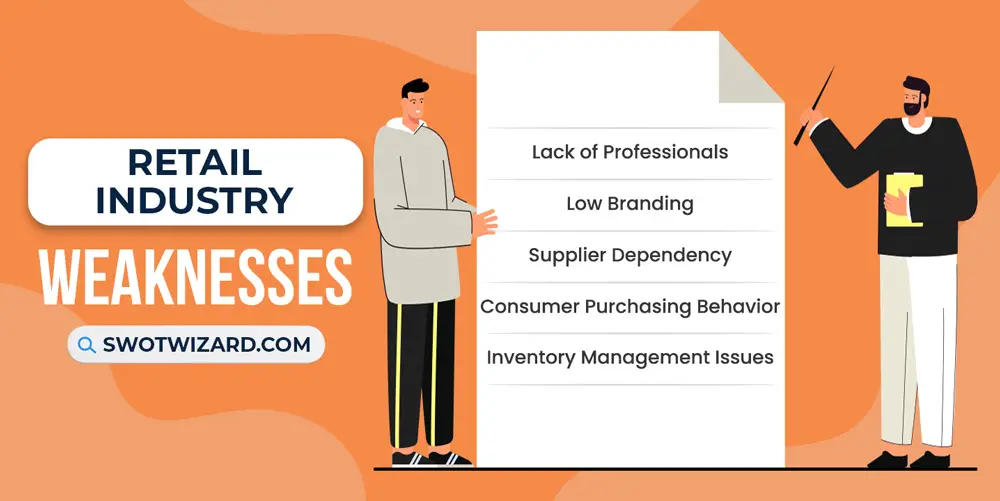
Lack of Professionals: The labor shortage, especially the lack of professionals, has always been an issue in the retail industry. As this industry’s unemployment rate has increased to 8.6% in recent years, the risk of a labor shortage has increased significantly, hampering the industry’s overall process.
Low Branding: The retail industry doesn’t focus on branding at all. Only a few companies, such as Walmart or Target, have their branding, but that’s specifically for the companies only. But from the industry’s perspective, the low branding has affected overall sales.
Supplier Dependency: When there are only a few suppliers for a product, the supplier’s bargaining power immensely increases and can negatively affect the overall industry. As a result, any minor inconvenience or price negotiation can jeopardize the small retailer’s business.
Consumer Purchasing Behavior: After covid-19 and the pandemic, people are now more concerned about finance, which affected purchasing behavior. Besides, with new trends, consumers want to spend money on something that can positively impact life and add value.
Inventory Management Issues: Inventory management in the retail industry is very challenging, and after the pandemic, the supply and demand curve has changed significantly. Retailers faced many issues regarding inventory in 2022, especially inventory storage in many products, as the demand has gone up for those.
Opportunities – Retail Industry SWOT Analysis
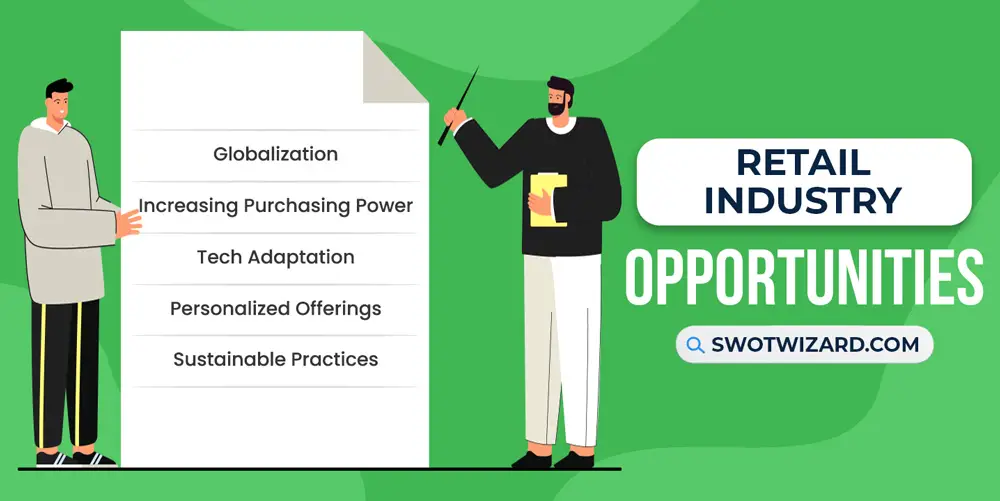
Globalization: One of the blessings brought to the retail industry is globalization. The global retail industry is expected to grow by 3.5% annually through 2025, and the total market size for the smart retail market will be $62.5 B by then. Besides, e-commerce sales are projected to reach 10.4% of all retail sales worldwide by 2023.
Increasing Purchasing Power: The study shows that consumers’ purchasing power has been rising for the last few years and has been steady, except for the pandemic year. And most of the purchases held by low and middle-income people are better now. As it is back on track now, people will spend more on necessary and retail products.
Tech Adaptation: There are tremendous opportunities, and there are many positive impacts of technological adaptation in the retail industry, such as effective inventory management, efficient supply chain, customer data management and analysis in an effective way to get customers’ demand, etc.
Personalized Offerings: With tech advancement and better analysis, it’s possible to understand customers’ exact needs by analyzing their buying patterns, wishlist, and the customized market in the retail industry is growing tremendously with a 12% growth rate, as people prefer more as their personal need.
Sustainable Practices: The world is going through tons of change because of carbon emissions, and every industry is doing its part, and so is the retail sector. Several practices are taken by the retail industry, such as reducing waste, utilizing renewable energy, and implementing eco-friendly packaging to minimize environmental impact.
Threats – Retail Industry SWOT Analysis
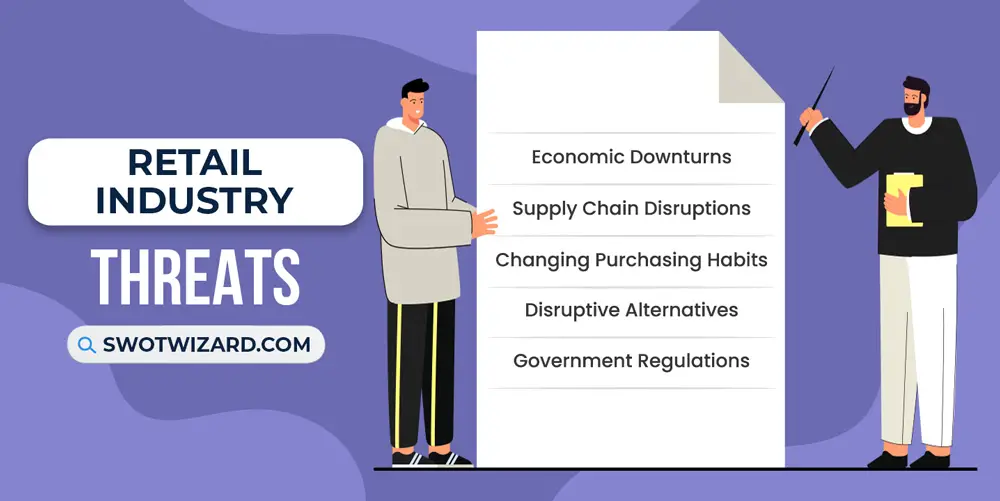
Economic Downturns: The 2008 recession significantly impacted the retail industry, with global retail sales declining by 3.6% in 2009. As inflation is already skyrocketing worldwide, and there are clear signs of a recession in the upcoming years, it will affect massively, and the industry will face losses.
Supply Chain Disruptions: The supply chain can have a massive impact on product availability to pricing. And the cost of these disruptions yearly totals more than a million in the USA alone. As an industry, it is high time to regain these situations in control; otherwise, they will start controlling the industry.
Changing Purchasing Habits: As positive as all the terms “globalization,” “e-commerce,” and others might sound, changing purchasing habits can harm the retail industry. With the rise of e-commerce and mobile shopping, many traditional brick-and-mortar retailers have struggled to keep up with changing consumer preferences.
Disruptive Alternatives: Disruptive alternatives, such as e-commerce and online marketplaces, have significantly impacted the traditional retail industry. As a result, it has decreased foot traffic, store closures, and job losses in the retail sector.
Government Regulations: Many government regulations limit store hours, prohibit certain products, or restrict advertising can hinder retailers’ ability to serve customers and grow their businesses. Besides, it can increase costs for retailers, which can ultimately be passed on to consumers in the form of higher prices.
[Bonus Infographic] SWOT Analysis of Retail Industry
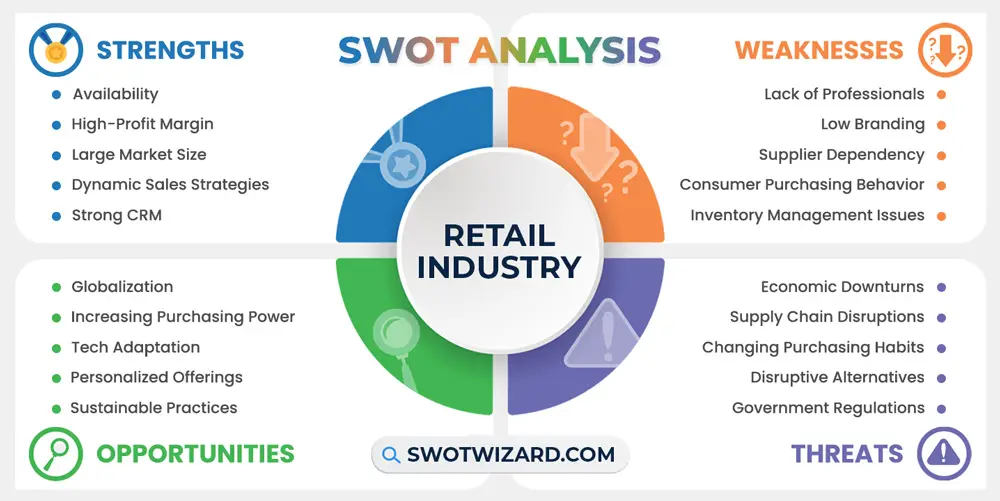
Recommendations for Retail Industry
Changes are normal in this era of globalization, and industries have to deal with various challenges and grab opportunities. Here are some of these for the retail sector.
- With these many tech advancements, retailers should focus on using data analytics to understand consumer behavior and preferences, implementing e-commerce platforms, and offering mobile payment options.
- Adapting technology could result in improving the shopping experience for customers.
- Retailers should focus on providing personalized experiences to customers, such as offering personalized recommendations, customized products, and targeted promotions based on customer preferences.
- Sustainable practices by retailers, such as using environmentally-friendly materials, and partnering with eco-conscious suppliers, will result in a positive image in consumers’ minds.
Frequently Asked Questions (FAQs)
Is Amazon a Wholesaler or Retailer?
Amazon is a wholesaler, not a retailer.
Is Retailer a B2B?
Yes, a retailer is a B2B.
Final Words on Retail Industry SWOT Analysis
The rise of e-commerce has disrupted traditional retail models, leading to decreased foot traffic and increased competition. However, the industry can leverage technology and focus on personalized omnichannel experiences to remain competitive. Additionally, investing in sustainable practices and employee training to improve customer loyalty will pay off by increasing market size. The retail industry faces significant challenges, but with strategic planning and adaptation, retailers can continue to thrive in a changing marketplace.
References
- Retail Market Analysis, Size And Trends Global Forecast To 2022-2030. (2022, July 13). The Business Research Company.
- Cox, J. (2023, February 15). Retail sales jump 3% in January, smashing expectations despite inflation increase. CNBC.
- How Does Supply Chain Management Impact the Retail Landscape? Experts at SpendEdge Explain. (2020, February 24). Business Wire.
- Tomsic, R. (2022). How can retail, restaurant, food and beverage companies tackle worker shortage risks? Marsh.
- Hofer, C., Jin, H. H., Swanson, R. D., Waller, M. A., & Williams, B. A. (2012). The Impact of Key Retail Accounts on Supplier Performance: A Collaborative Perspective of Resource Dependency Theory. Journal of Retailing, 88(3), 412–420.
- Tao, H., Sun, X., Liu, X., Tian, J., & Zhang, D. (2022). The Impact of Consumer Purchase Behavior Changes on the Business Model Design of Consumer Services Companies Over the Course of COVID-19. Frontiers in Psychology, 13.
- Zimmerman, S. (2022, December 20). A tidal wave of inventory walloped retailers in 2022. Supply Chain Dive.
- At a CAGR of 23.6% Smart Retail Market is Expected to Reach USD 62.5 billion by 2025 Globally – Report by MarketsandMarketsTM. (2022, November 7). GlobeNewswire.
- New purchasing power parities show low- and middle-income economies account for half of the global economy. (2020, May 19). World Bank.
- Knox, T. (2022, January 25). Three Technology Trends Transforming The Retail Industry. Forbes.
- Lindecrantz, E., Tjon Pian Gi, M., & Zerbi, S. (2020, April 28). Personalizing the customer experience: Driving differentiation in retail. McKinsey & Company.
- How retailers are grappling with sustainability. (2022, June 28). Retail Dive.
- Thomas, L., & Hirsch, L. (2018, September 18). 10 years after the financial crisis, Americans are still looking for a deal. CNBC.
- Drenik, G. (2022, August 30). It’s Time For Retailers To Take Back Control Of Their Supply Chains. Here’s How. Forbes.
- Here’s a list of 148 bankruptcies in the retail apocalypse – and why they failed. (2023, January 30). CB Insights.
- Government Regulations That Affect Marketing in Retail. (2021, April 15). Chron.com.

